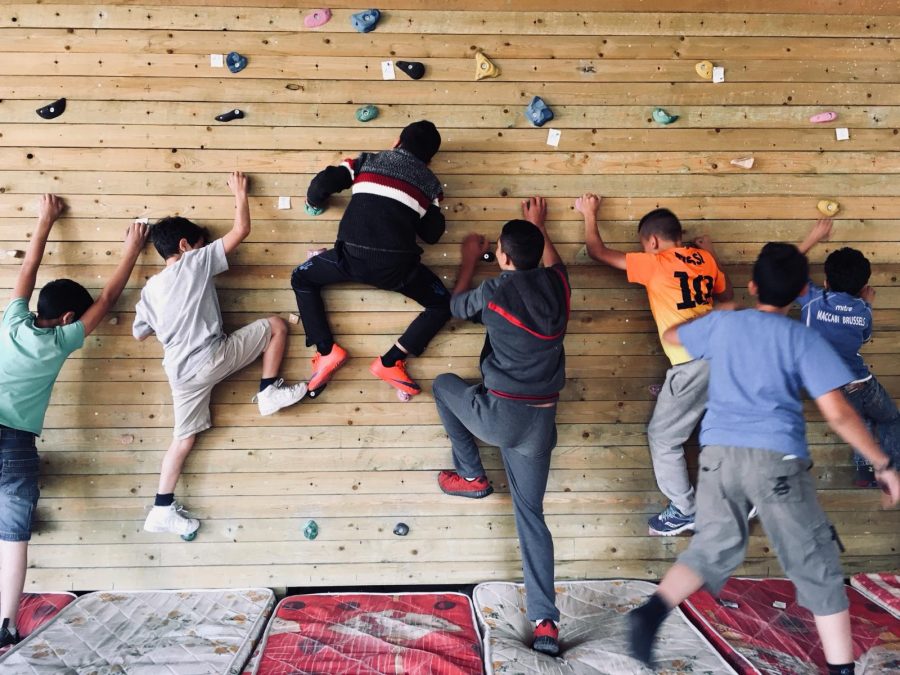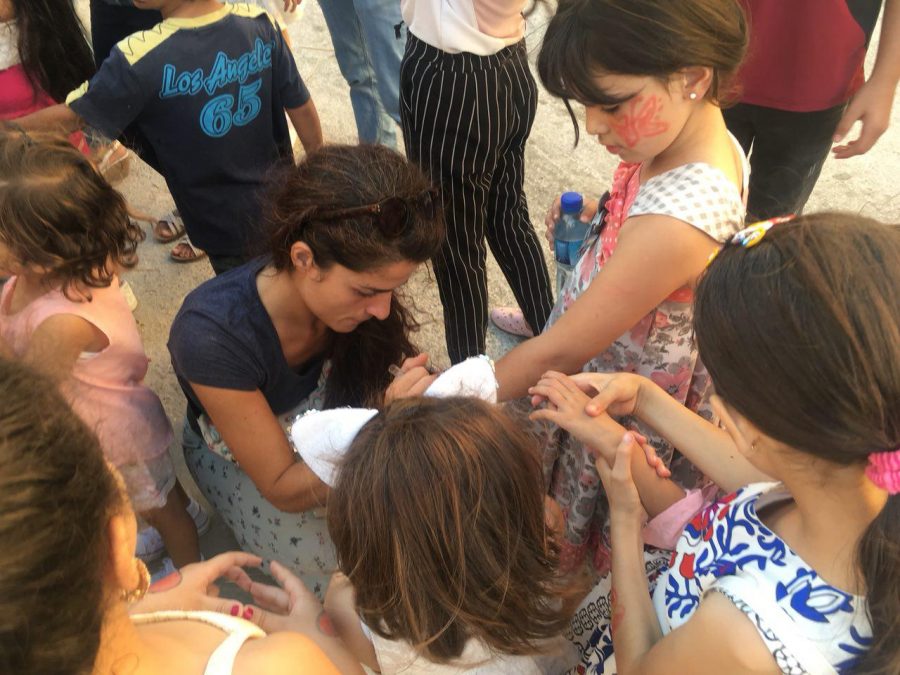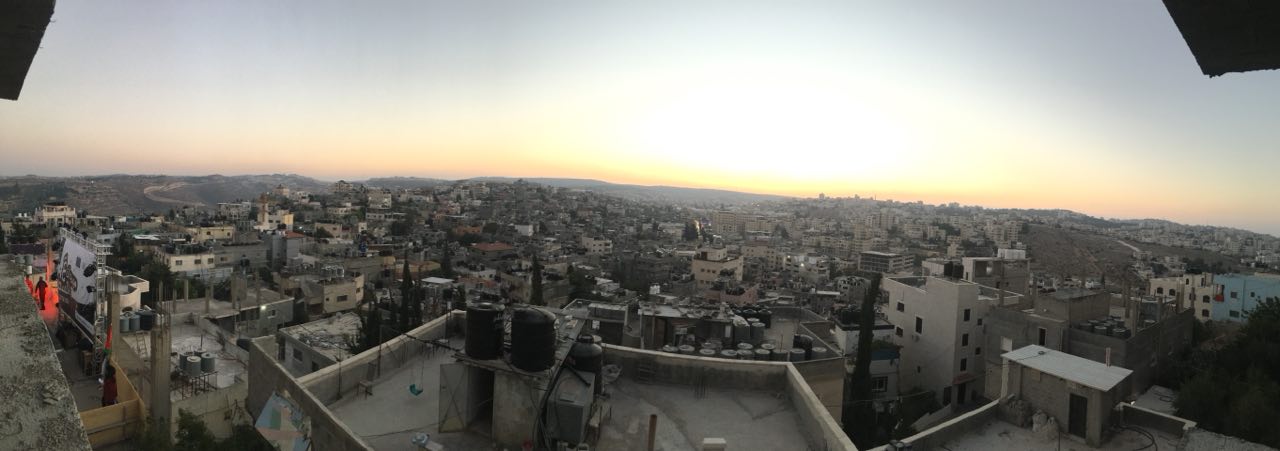PROJECT FOR CHILDHOOD IN PALESTINE 2018/2019

INTRODUCTION
I had the opportunity to be in Palestine for a period from December 2017 to January 2018 thanks to a political and sport exchange based on climbing.
In that period, I could get in touch and know the country, its cities, its population.
As a group, we were guests of Laylac, an association that is situated in the refugee Camp of Deheisheh.
Among different projects, Laylac deals with different activities for children, as painting, skateboarding, and the free-climbing for teenagers and young people.
It’s important to outline that this exchange project started also thanks to other foreign people.(????)
We contributed to this, by bringing the climbing facilities and the right tools for the guys and girls that usually visit Laylac. In this way they can climb freely without depending on the presence of someone.
Moreover, our contribution was based on looking for new places where to climb. Although this activity is so common in all the countries, in Palestine is limited, because of the occupation.
We hope that next time it will be possible to move on finding new route to explore and to climb.
In the future it would be great if we can nail some “Falesie” near Bethlehem.
In this short period, in the reality of the refugee camp, I had the possibility to know all those people that face the difficulties of their daily life with strength and a catching smile.
They carry on with their life trying to coordinate work, family and the life in the Camp, where the basic things are not for granted: for instance, the water and the electricity depend always on the control of the Israeli occupation.
Apart from the basic needs, the raids and attack of the Israeli army in the Camp happen often, twice a week and normally at Dawn.
These attacks have the purpose of arresting young guys (from 12 to 22 years old) participating to the the Palestinian fight for freedom and to suffocate any hope for the future, as the hope of the youngsters.
In this hard socio-political context, I learned that the belonging to the land and the importance of the collective history, are the keywords for every Palestinian.
Indeed, the children grow up with this feeling of belonging and taking part to the political fight for Palestine.
This is evident if you go to the demonstration that often occurs on Friday. You can see children of the age of 5 years old. For us European, watching little kids throwing stones against the Israeli tanks or escaping from the gasses is shocking, if we consider that is even impossible to see 5 or 6 years old children walking alone in the street.
These children get used very soon to this as to other problems related to the life in the camp, where for example, you can’t build a complete house, because the army prevent you from doing it, and at least twice a month the roof of the house is destroyed.
WALDORF’ S PEDAGOGY
Since 2012, after a period of studying and practising, I am teaching in the Waldorf school in Milan.
The Waldorf Pedagogy is based on the idea that the education process must enable the child to grow up and be an independent individual free to act, think and speak. This means that teachers (that the child or the guy has to refer to) have the mission of giving to the student every possible tool to become an adult able to choose his or her path independently and consciously .
Since the target of this project are children of the age from 2 years old to 6/7 years old, it could be useful to use the activities that the Waldorf Pedagogy teaches to stimulate the child from a physical and intellectual point of view in order to strengthen the body and the will of the child.
This happens of course in an unconscious way for the children, since they will develop the activity as a game.
Some of these activities, like wax modelling, the use of watercolours, the drawning can be performed also in Deheisheh without difficulty.
At this age the child relates himself or herself with the life outside their houses in a direct way and they experience it also through the example of the adults around them.
In this phase it’s important to avoid sharing with the children some cognitive processes that are typical of the adults and that for the child are not understandable, because he or she has not developed yet a proper ability to discover the world through the mind, but just with the body and the senses. Sharing with the child other things from the contact trough the body etc. …, it’s an overstimulation and he or she could stop experiencing through the game, fantasy and senses
(touch, taste, smell, sight, hearing).
PROJECT ABOUT THE CHILDREN’S REAPPROPRIATION OF THEIR CHILDHOOD (WITH AN EDUCATIONAL AND PEDAGOGICAL PURPOSE)
For all these reasons I believe that a kindergarten for children based on the above-explained pedagogy is necessary and fundamental.
Indeed, not all the children have the same opportunity to live and use this kind of facilities that could be adequate to them, either for family reasons or because there aren’t facilities at all.
That’s why it’s often the community as a whole that takes care of the children, following a habit called “the school of the street”. The children are quite safe, but the reality that they live everyday doesn’t give them the opportunity to enjoy an activity or a game that is suitable for their age, something that enables them to read their reality through activities that are understandable and reproducible.
This is useful especially if you think that the children relate with these hard situations and problems through the adult’s way of expressing them. If on one side this enables them to take their responsibility politically for their land, on the other side they don’t experience activities and games that are innocent, simple, creative and positive, and that should be so common for their age.(2 – 7 years old).
If we consider also that in this period children start to imitate unconsciously the adults, and, in this context, this means to fight everyday for basic needs, to stand up for the rights, to stand up for the land, for the houses etc. …, they will not have the tools to go out from this mechanism, because their way of playing and expressing themselves is limited.
My project – proposal is based exactly on this, the reappropriation: to give the children of this age a “safe” area, where you can experiment without influences coming from the society, a free space where the children can play freely
THE PROJECT
It will be a 9 months project, hopefully from October 2018 to June 2019. The activities with the children would take place 2/3 afternoon a week. This timetable can convey either a sort of routine in the children’s life ( because if you do the same thing day by day you start to know it and this gives you self-confidence and the feeling of being safe) or it can become like the relevant moment during the day where they can feel safe.
The place where this project will be hosted is Laylac, because it is already equipped with the facilities for youngsters and children and they already organize activities for children.
Laylac is a key spot for the community of Deheisheh Camp.
As it happened in a Waldorf Kindergarten, there will be different activities in relation to different days.
Moreover, the children will be involved also in sport activities: in details, there will be a climbing day inside Laylac or in the neighbourhood of Bethlehem, where there is a climbing site where it is possible to climb in safety. This part is strongly linked to the Climbing project developed in December 2017 , to give it continuity.
The other activities will deal mostly with the drawing, way crayon, water colours, wax modelling, but most of all the free game.
Besides, it has been agrred with Laylac that I will follow some classes in 2 or 5 Kindergarten of Dehiesheh and maybe Aida Camp, so that I can learn and exchange methods and strategiesorder to develop a real work and cooperation experience.
THE ACTIVITIES PROPOSED:
THE DRAWING: It’s the unconscious way for children to express themselves. When the child is 2-3 years old his or her drawings appear to us as illogic. In reality, we can always detect some organic experiences that children live without being conscious. For this reason, it’s important that the children experience the drawing, an experience that will become more defined and real with the time passing (that is until they will draw bodies and object in a more similar way). The material to use will be way crayon (cube – shaped) and the big pencils in order to teach how to handle with pencils or pens when you write or paint.
WATERCOLOURS: It is a very important experience with colours, because, thanks to the water that is an element with no shape exactly like a child of that age, water colours can convey a peculiar experience. This happens because of the fact that the children have not developed concepts or ideas in their mind yet, but with the watercolours they can move freely on the paper mixing the colours. (the primary ones)
WAX MODELLING: The wax modelling puts in connection the touch with the experience of warmness. Using warmed fingertips, the children will model the wax: the more the children are little, the more the sculptures haven’t definite shape. Growing up they will reproduce bodies and object from the environment surrounding them. It’s an activity that develops the dexterity.
FREE GAME: this is the most important moment in the daily life of a child. Supported by few natural objects or materials (hood, fabrics…), the child imitates scenarios that they witness in the adult’s world. It’s important to let the children play alone without interfering and it’s important to try to give them good example to imitate, speaking about being adults and to show “positivity” to the child.
BUDGET
The project will be sustained by the costs for the materials and for the teacher (room and board and other costs related to travels).
Materials:
white papers A4
100 crayons (cube-shaped) and big crayon – pencils in different colours
100 colored pencils
12 painting colours
50 brushes
50 little bowls for the painting colours
50 painting tablets
wool to create dolls and needles to work on it (donation)
climbing facilities (donation)
evetually, the rent of a little van.
| MATERIAL | NUMBER OF ITEMS NEEDED |
| Cleansing Material | 2 brooms 2 shovel |
| Climbing facilities for children | |
| White paper reem, A4 | 10 |
| Cube-shaped crayons | 50 boxes of different colours |
| Big crayon – pencils | 50 boxes of different colours |
| Big coloured pencils, triangular | 20 boxes |
| painting colours | 12 cans of different colours |
| brushes | 50 |
| Wax layers | 20 boxes of different colours |
| (textile) wool | |
| Painting tablets | 20 |
| pic 1: kids climbing in an artificial wall inside the association Laylac
pic 2: kids during the first cultural festival inside the deisha campPainting papers |
3 reems |
| Made of natural material toys | |
| Total |
Others costs:
Trips and group excursions: as told in the project we are going to have one or two excursions per month in the city area of Betlemme and in the countryside, especially for climbing. We will rent a bus with driver. For this activities we need budget wich include the costs for trasportation and food for children and teacher and for the personal insurance.
Teacher’s refund: it will be necessary to plan an economical refund for the teacher. It will include the residence, board, phone bills, internet service, airplan tickets and Arabic language course at the Bethelhem University, others.
The expetation of the final budget is around 10,000 euro, for all the materials, trips and excursions and teacher refund.

